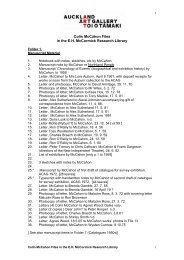Create successful ePaper yourself
Turn your PDF publications into a flip-book with our unique Google optimized e-Paper software.
Paintingslayers. Exposure to light will speed up the acid degradationof the canvas, non-archival cardboard, or particleboard supports resulting in discoloration and embrittlement.Paintings are vulnerable to fading from light, butbecause they usually have a thicker layer of pigmentthan works on paper, it takes longer for this to benoticeable. The heat generated by light can cause desiccationor contribute to the damage to paintings causedby fluctuating humidity levels.Keep paintings out of direct sunlight or high levelsof indirect sunlight. <strong>Art</strong>ificial light sourcesshould be kept at a distance to preventheating, with light levels below 200 luxand ultraviolet less than 50 microwatts perlumen.Relative Humidity and Temperature—fluctuationsin relative humidityare particularly harmful as they promotedimensional instability in paintings.Differing reactions to changes in humidityby the various materials in a painting willresult in stress building up between layerswith possible bond failure. For example,while the canvas or wooden support swellsand shrinks in response to fluctuations in humidity, thepaint layer will change very little in size and as a resultcracking and flaking can occur.Excessive heat and humidity are other main causesof damage from the environment. Dryness can causewarping of cardboard, wooden supports and stretchers,and the cracking of paints. Dampness encourages mouldgrowth and insects. It is important to note that paintingswill have an extreme reaction to wetting, and crackingand delamination of the paint layer is a common result.The ideal humidity level for paintings in NewZealand is between 50 and 60% relative humidity.Fluctuations should be kept to a minimum and dampareas or heat sources avoided.Mechanical Damage, Dirt and Stains—paintingsmust be handled carefully because they are surprisinglydelicate. Movement in the support through flexing, saggingor vibration can cause a brittle oil paint layer tocrack. A canvas support is particularly vulnerable totears and blows which can crack and dislodge the paint.Paintings on cardboard, hardboard and plywood can easilybe chipped around the edges.Many contemporary paintings rely on very delicatesurface effects. Acrylic paints are thermoplastic so theyremain soft at room temperature and can be permanentlysoiled by handling. Other materials used to createchalky and waxy finishes are alsoextremely susceptible to damage fromabrasion and fingermarks.Paintings are most at risk when theyare being moved, or are forgotten about instorage.Biological—paintings can be damagedby animals, insects and mould. Insectssuch as borer can attack wooden supports,and canvas and cardboard supports areopen to attack by silverfish. Insects canalso attack proteinaceous materials in thepaint layers such as glue-size or the egg intempera. Fly or spider spots stain the paintlayer and become insoluble in the course of time. Mouldcan cause staining and weakening of the support, and willdull and discolour the paint layers.Temperature control, good air circulation, regulardusting of the paint surface and other suggestions underInsects and Mould (see also page 5) are the best methodsof prevention. There are very few fumigants suitable foruse with paintings, so fumigation should be avoidedunless specific conservation advice has been sought.Atmospheric Pollutants—can cause damage topaintings. For example, hydrogen sulphide which isfound in high levels in Rotorua accelerates deteriorationin the organic components of pictures and canchemically change the colour of many pigments.Because paintings are often unprotected by glass, sticky32
















